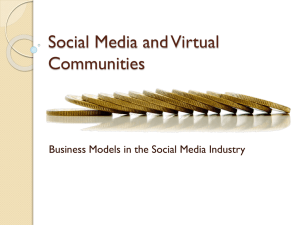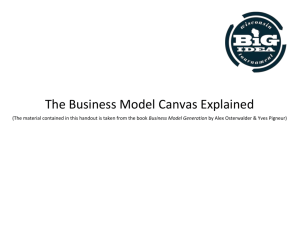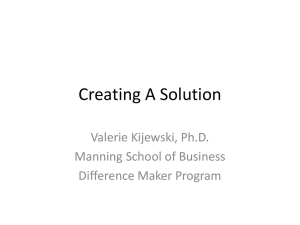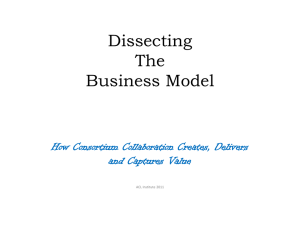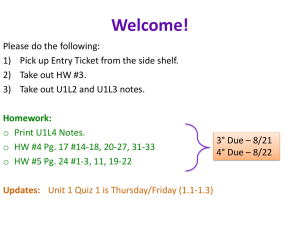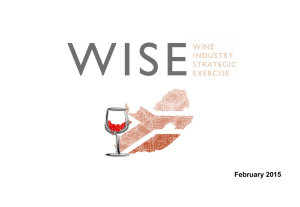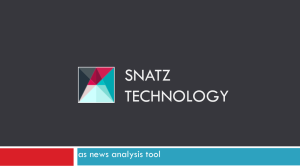Customer Relationships
advertisement
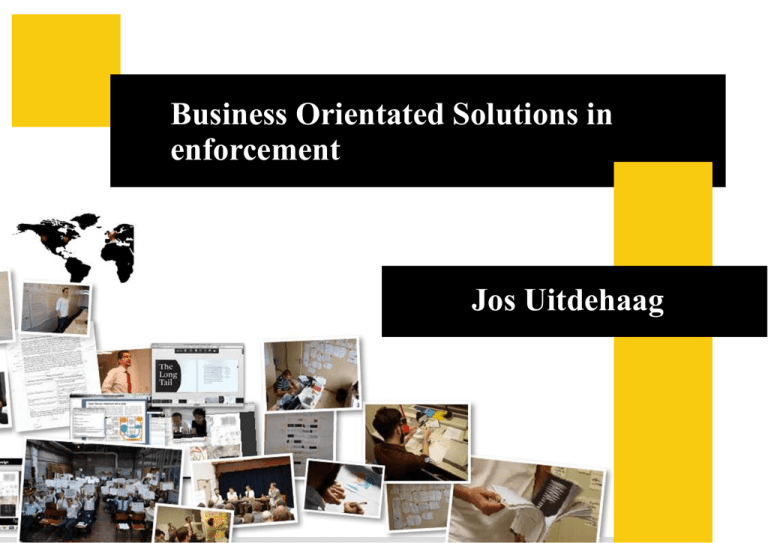
Business Orientated Solutions in enforcement Business Orientated Solutions in Jos Uitdehaag enforcement Business Model A business model describes the rationale of how an organisation creates, delivers and captures value. Business Model: “Every organisation, whether a business or not, has a theory of the business. Indeed, a valid theory that is clear, consistent, and focused is extraordinarily powerful”. Peter Drucker, Harvard Business Review, Sept-Oct, 1994 – ‘The Theory of the Business’, p. 96. [italics added] Business Model In other words: in theory there is no difference whether we are talking about a private business orientated or a state based organization And in practice???? Contact The business model is like a blueprint for a strategy to be implemented through organizational structures, processes, and systems A business model can best be described through nine basic building blocks that show the logic of how a company intends to make money. The nine blocks cover the four main areas of a business: customers, offer, infrastructure, and financial viability The Building The building blocks Blocks Customer Segments An organization serves one or several Customer Segments. Value Propositions Channels Customer Relationships It seeks to solve Customer problems and satisfy customer needs with value propositions. Value propositions are delivered to Customers through communication, distribution, and sales Channels. Customer relationships are established and maintained with each Customer Segment. The building blocks Revenue streams Revenue streams result from value propositions successfully offered to customers. Key resources Key resources are the assets required to offer and deliver the previously described elements… Channels Key partnerships Cost structure …by performing a number of Key Activities. Some activities are outsourced and some resources are acquired outside the enterprise. The business model elements result in the cost structure. The Building Blocks – Customer Segments Customer Segments mass market - niche market - segmented - diversified - multi-sided platforms - The Customer Segments Building Block defines the different groups of people or organizations an enterprise aims to reach and serve The Building Blocks – Value Propositions Value Proposition Customer Segments newness: IT use - performance - customisation - getting the job done - design - brand/ status - price - cost reduction - risk reduction - accessibility - convenience/ usability - The Value Propositions Building Block describes the bundle of products and services that create value for a specific Customer Segment The Building Blocks – Channels Value Proposition Customer Segments - own - partner - direct - indirect Channels The Channels Building Block describes how a company communicates with and reaches its Customer Segments to deliver a Value Proposition The Building Blocks – Customer Relationships Value Proposition Customer Segments Customer Relationships - personal assistance - dedicated personal assistance - self-service - automated services - communities - co-creation Channels The Customer Relationships Building Block describes the types of relationships a company establishes with specific Customer Segments The Building Blocks – Revenue Streams Value Proposition Customer Segments Customer Relationships - asset sale - usage fee - subscription fees - lending/ renting/ leasing - licensing - brokerage fees - advertising Revenue Streams Channels The Revenue Streams Building Block represents the cash a company generates from each Customer Segment (costs must be subtracted from revenues to create earnings) The Building Blocks – Key Resources Value Proposition Customer Segments Customer Relationships - physical - intellectual - human - financial Key Resources Revenue Streams Channels The Key Resources Building Block describes the most important assets required to make a business model work The Building Blocks – Key Activities Value Proposition Customer Segments Customer Relationships Key Activities - production - problem solving - platform/ network Key Resources Revenue Streams Channels The Key Activities Building Block describes the most important things a company must do to make its business model work The Building Blocks – Key Partnerships - optimisation/ economy of scale - reduction of risk & uncertainty - acquisition of resources and activities Value Proposition Customer Segments Customer Relationships Key Activities Key Resources Key Partnerships Revenue Streams Channels The Key Partnerships Building Block describes the network of suppliers and partners that make the business model work The Building Blocks – Cost Structure - cost-driven - value-driven - fixed costs - variable costs - economies of scale - economies of scope Key Partnerships Customer Segments Value Proposition Customer Relationships Key Activities Key Resources Cost Structure Revenue Streams Channels The Cost Structure describes all costs incurred to operate a business model Contact 26796__TC-diagram126796__TC-diagram126796__TC-diagram126796__TC-diagram1 The Business Model Canvas - Example KP KA Customers who build new LEGO designs and post them online become key partners generating content and value LEGO has to provide and manage the platform/ logistics that allow packaging/ delivery of customer made sets KR LEGO has not yet fully adapted its resources and activities, which are optimised primarily for the mass market C$ The Factory leverages production and logistics costs already incurred by its traditional retail mode VP CR LEGO Factory substantially expands the scope of the off-the-shelf kit offering by giving LEGO fans the tools to build, showcase, and sell their own custom designed kits CS LEGO Factory builds a Long Tail community around customers who are truly interested in niche content and want to go beyond off-the-shelf kits CH LEGO Factory’s existence depends heavily on the Web channel R$ Thousands of new, customer designed kits perfectly complement LEGO’s standard sets of blocks. LEGO Factory connects customers who create customised designs with other customers, thus becoming a customer matchmaking platform and increasing sales LEGO Factory aims to generate small revenues from a large number of customer designed items. This represents a valuable addition to traditional high-volume retail revenues. Alexander Osterwalder
